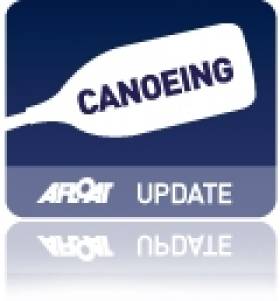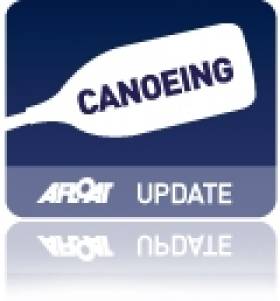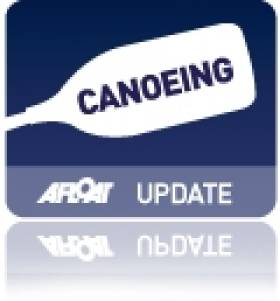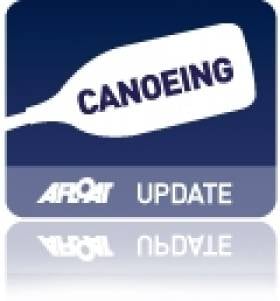Displaying items by tag: canoeing
Ryan Best of Irish K1 Competitors at Canoe Slalom World Championships
#Canoeing: Cade Ryan was the most impressive of Ireland’s three competitors in the K1 at the canoe slalom World Championships in Lee Valley in England today. Ryan clocked 90.42 seconds and 89.69 in the two runs, with no penalties on either. Elliott Davidson and Sam Curtis were pushed well down the rankings, through penalties on both runs.
Canoe Slalom World Championships, Lee Valley, London, Day Three (Irish interest)
Men
K1 – First Run (top 30 to Semi-Finals): 60 C Ryan 90.42; 98 S Curtis 145.17 (incl 54 seconds penalty); 102 E Davidson 203.59 (incl 104 sec pen). Second Run (10 qualify): 27 Ryan 89.69; 41 Davidson 99.06 (incl 6 sec pen); 65 Curtis 146.05 (incl 56 sec pen).
Liam Jegou Excels in Second Run to Claim Semi-Final Place at World Championships
#Canoeing: Liam Jegou qualified for the semi-final of the canoe slalom World Championships in Lee Valley, England today. The France-based teenager produced an impressive, penalty-free, second run in the C1 to place ninth, with 10 places available. In his first run, he incurred penalties on gates eight and 11 and had four seconds in penalties, but would have fallen outside qualification in any case. Jake Cochrane placed 68th and 64th in his two runs.
Canoe Slalom World Championships, Lee Valley, London, Day Two (Irish interest)
Men
C1 – First Run (top 20 to semi-finals): 37 L Jegou 95.98 seconds (incl 4 sec pen); J Cochrane 161.15 (incl 54 sec pen). Second Run (10 qualify): 9 Jegou 90.83; 64 Cochrane 108.38 (incl 8 sec pen).
Women
C1 – First Run (top 15 to semi-finals) 32 C O’Ferrall 191.62; Second Run: O’Ferrall 132.14 (incl 4 sec pen)
#CANOEING: Jenny Egan finished fourth, in a photo finish, in the final of the K1 5000 metres at the European Games in Azerbaijan today. Egan was just .455 of a second off matching the bronze medal she achieved at the European Canoe Sprint Championships in the Czech Republic in May. That race was won by Maryna Litvinchuk of Belarus, who again took gold today in Baku. Britain’s Lani Belcher, who was second, and Renata Csay of Hungary edged Egan out of medal contention. Both were within .7 of a second of Egan’s time.
Earlier Jenny Egan finished sixth in the B final of the K1 500 metres, 15th overall. Andrzej Jezierski finished fourth in the B Final of the men’s C1 200 metres, 13th overall. Peter Egan finished 21st in the men’s K1 5,000 metres.
European Games 2015, Baku, Azerbaijan
Canoe Sprint (Irish interest)
Men
C1 200 – B Finals (Places 10 to 18): 4 A Jezierski 42.244 seconds.
K1 5000 – Final: 21 P Egan 23 mins 13.183.
Women
K1 500 – B Final (Places 10 to 18): 6 J Egan 2 min 11.396 seconds.
K1 5000 – Final: 1 Belarus (M Litvinchuk) 22 min 48.990 secs, 2 Britain (L Belcher) 23:05.625, 3 Hungary (R Csay) 23:05.851; 4 Ireland (J Egan) 23:06.306.
Jezierski and Jenny Egan To Compete in B Finals in Baku
#CANOEING: Ireland’s Andrzej Jezierski qualified for the B Final (places 10 to 18) of the men’s C1 200 metres at the European Games in Baku, Azerbaijan today. Jezierski finished sixth in his heat but improved to fifth in his semi-final. Jenny Egan will compete in the B Final of the K1 500, having qualified on Sunday. She made the semi-finals in the K1 200m but her eighth-placing there means she did not make it through to the A or B final. She is also set to compete in the K1 5000m straight final tomorrow.
Peter Egan and Simas Dobrovolskis finished eighth of eight in their heat of the K2 200m and did not qualify for the semi-finals, while Tom Brennan in the K1 200 made it to the semi-finals but finished outside the qualification mark for the A and B Finals.
European Games 2015, Baku, Azerbaijan
Canoe Sprint (Irish interest)
Men
K2 200 – Heat One: 8 P Egan, S Dobrovolskis 35:049.
K1 200 – Heat Two: 6 T Brennan 35.446. Semi-Final: 8 Brennan 36.191.
C1 200 – Heat One: 6 A Jezierski 42.339 seconds. Semi-Final One: 5 Jezierski 40.277
Women
K1 200 – Heat Three: 6 J Egan 42.843. Semi-Final Two: 8 J Egan 42.657.
K1 500 – Heat One: 6 J Egan 1:55.468. Semi-Final: 7 J Egan 1:52.536.
Jenny Egan Seventh at World Cup
#CANOEING: Jenny Egan finished seventh in the K1 5,000 metres at the Canoe Sprint World Cup in Duisburg in Germany today. The race was won by Lani Belcher of Britain, and Britain also took bronze through Louisa Sawers, with Serbian Kristina Bedec second. Egan took a bronze medal at the European Championships in this event, but she was over half a minute behind Sawers today
Canoe Sprint World Cup, Duisburg, Germany (Irish interest)
Men
Paracanoeing: KL3 200 – Final: 1 Germany (T Kierey) 41.305, 2 Russia (A Voronkov) 42.247, 3 Britain (T Lodge) 42.891; 4 Ireland (T O’Leary) 43.486.
Women
K1 5,000m: 7 J Egan 22 min 24.634.
Jenny Egan in World Cup Semi-Final at Duisburg
#CANOEING: Jenny Egan qualified for the semi-final of the K1 200 metres by finishing fourth in her heat this evening at the Canoe Sprint World Cup in Duisburg. Egan also qualified for semi-finals of the K1 500m, but finished seventh and takes a place in the the C Final (places 19 to 27). Barry Watkins and Michael Fitzsimons, in the K2 1,000, also qualified for the semi-finals, but their ninth-place finish meant they missed out on the C Final. Tom Brennan qualified for the semi-final of the K1 200m. Ireland will have at least one finalist, as paracanoeist Pat O’Leary took second in his heat of the KL3 200 metres.
Canoe Sprint World Cup, Duisburg, Germany (Irish interest)
Men, KL3 200m – Heat Two (First Three Directly to Final; rest to Semi-Final): 1 Germany (T Keirey) 41.870 seconds, 2 Ireland (P O’Leary) 44.245, 3 Russia (V Potanin) 44.658.
K2 1000m – Heat Four: 6 B Watkins, M Fitzsimons 3:21.908. Semi-Final Three: 9 Watkins, Fitzsimons 3:21.699.
K2 200 – Heat One: 9 P Egan, S Dobrovolskis 34.976.
K1 200m – Heat Three: 5 T Brennan 37.462
Women
K1 200 – Heat One: 4 J Egan 44.171 seconds (to Semi-Final).
500m – Heat One: 7 J Egan 1:57.293. Semi-Final Three: 7 Egan 1:55.688.
B Finals for Egan and Brennan at European Sprints
#CANOEING: Jenny Egan and Tom Brennan moved into B Finals but Andrzej Jezierski did not start his semi-final of the C1 200 at the European Canoe Sprint Championships in Racice in the Czech Republic. Egan was competing in the K1 200 and Brennan in the men’s equivalent. Peter Egan and Simas Dobrovolskis finished eighth in their heat and did not make it to the semi-final.
European Canoe Sprint Championships, Racice, Czech Republic (Selected Results; Irish interest)
Men
K2 200 – Heat Three (First Three to A Final; 4-7 to B Final; rest out): 1 Serbia 31.676; 8 P Egan, S Dobrovolskis 34.808.
C1 200 - Heat Three (Winner to Final; second to seventh to semi-final): 1 Portugal (H Silva) 39.236; 7 A Jezierski 43.220. Semi-Final: Jezierski did not start.
K1 200 – Heat Two: 6 T Brennan 37.596. Semi-Final (First Three to A Final, 4-7 to B Final): 1 Latvia (A Rumjancevs) 36.072; 7 T Brennan 37.852
Women
K1 200 – Heat Three (Winner to Final; second to seventh to semi-final): 1 Serbia (N Moldovan) 40.236; 7 J Egan 43.384. Semi-Final (First Three to A Final, 4-7 to B Final): 1 Russia (N Podolskaya) 42.196; 7 Egan 45.344.
Hendrick Twins Place Fourth in World in Brazil
#CANOEING: Noel and Robert Hendrick narrowly missed a podium finish at the Junior and Under-23 Canoe Slalom World Championships in Brazil. The twin brothers, competing in a Junior C2 (Canadian canoe), finished fourth behind French, Czech and German pairings. The Hendricks compete for Ribbontail Canoe Club in Enfield in County Meath. Three Ireland competitors exited at the semi-final stage: Jake Cochrane (C1, Under-23), Aisling Conlan (K1, Under-23) and Robert Hendrick (C1 Junior). The Hendrick brothers are set to compete at the European Junior and Under-23 Canoe Slalom Championships in Poland next August.
ICF Canoe Slalom Junior and Under-23 World Championships, Foz do Iguassu, Brazil (Selected Results) – C2 Men, Junior: 1 France 104.25 seconds, 2 Czech Republic 101.64, 3 Germany 105.55; 4 Ireland (N Hendrick, R Hendrick) 109.91.
Irish Student Dies On Slovenia Canoeing Trip
#Canoeing - The death of an Irish student on a canoeing trip in Slovenia is the second tragedy to befall a north Dublin college's adventure sports management course, as The Irish Times reports.
The young man, who has not yet been named, was canoeing on the Soca river as part of an official trip to Slovenia organised by Coláiste Dhulaigh in Coolock.
It's reported that the "accomplished and experienced" canoeist was paddling through a stretch of whitewater when his arm got stuck in the rocks.
Despite the best efforts of his fellow students to rescue and revive him, he was pronounced dead shortly after.
The incident comes five months after another student on the same course, 21-year-old Shane Murphy from Baldoyle, lost his life while kayaking with friends on the swollen River Inchavore.
The Irish Times has more on the story HERE.
Canoeing Ireland Recruiting Youth & Club Development Officer
#Canoeing - Canoeing Ireland is recruiting a Youth & Club Development Officer to develop youth participation in canoeing and increase both the quantity and quality of canoe clubs in Ireland.
The successful candidate will be in charge of managing the Canoeing Ireland Training Centre with a focus on youth participation, which includes managing delivery of the instructor training initiative in view of club development.
They will also be expected to deliver junior training programmes – and a schools, scouts and youth competition calendar – across a broad range of disciplines.
Managing and delivering adult training programmes to kick start club growth and development will also be part of their remit, as will reviewing and developing new Canoeing Ireland club support materials, including the Club Kick Start Pack, sample constitution and sample SOPs and risk assessments.
Among the biggest requirements will be establishing a Canoeing Ireland Youth Kayaking Academy at the body's training centre at Strawberry Beds as a pilot project to be rolled out to towns and cities nationwide.
The successful candidate will also be expected to contribute at strategic events such as the Liffey Descent and junior and senior Paddlefests, as well as produce content for Canoeing Ireland's print and social media platforms.
Applicants must have at least a level 3 kayak instructorship, a full clean minibus driver's licence, a current CI-recognised first aid cert and a Coaching Ireland tutor qualification, among other requirements. All applications are also subject to Garda vetting clearance.
Full details on this role and how to apply are available via the Canoeing Ireland website HERE - which also has details on a vacancy for an administration officer. Applications must be received by Friday 16 January 2015.



































































